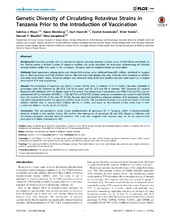| dc.contributor.author | Moyo, Sabrina John | en_US |
| dc.contributor.author | Blomberg, Bjørn | en_US |
| dc.contributor.author | Hanevik, Kurt | en_US |
| dc.contributor.author | Kommedal, Øyvind | en_US |
| dc.contributor.author | Vainio, Kirsti | en_US |
| dc.contributor.author | Maselle, Samwel Y. | en_US |
| dc.contributor.author | Langeland, Nina | en_US |
| dc.date.accessioned | 2014-12-08T13:14:05Z | en_US |
| dc.date.accessioned | 2014-12-09T08:36:12Z | en_US |
| dc.date.accessioned | 2014-12-10T10:23:47Z | |
| dc.date.available | 2014-12-10T10:23:47Z | |
| dc.date.issued | 2014-05-20 | eng |
| dc.identifier.issn | 1932-6203 | |
| dc.identifier.uri | https://hdl.handle.net/1956/8882 | |
| dc.description.abstract | Background: Tanzania currently rolls out vaccination against rotavirus-diarrhea, a major cause of child illness and death. As the vaccine covers a limited number of rotavirus variants, this study describes the molecular epidemiology of rotavirus among children under two years in Dar es Salaam, Tanzania, prior to implementation of vaccination. Methods: Stool specimens, demographic and clinical information, were collected from 690 children admitted to hospital due to diarrhea (cases) and 545 children without diarrhea (controls) during one year. Controls were inpatient or children attending child health clinics. Rotavirus antigen was detected using ELISA and positive samples were typed by multiplex semi-nested PCR and sequencing. Results: The prevalence of rotavirus was higher in cases (32.5%) than in controls (7.7%, P,0.001). The most common G genotypes were G1 followed by G8, G12, and G4 in cases and G1, G12 and G8 in controls. The Tanzanian G1 variants displayed 94% similarity with the Rotarix vaccine G1 variant. The commonest P genotypes were P[8], P[4] and P[6], and the commonest G/P combination G1 P[8] (n = 123), G8 P[4] and G12 P[6]. Overall, rotavirus prevalence was higher in cool (23.9%) than hot months (17.1%) of the year (P = 0.012). We also observed significant seasonal variation of G genotypes. Rotavirus was most frequently found in the age group of four to six months. The prevalence of rotavirus in cases was lower in stunted children (28.9%) than in non-stunted children (40.1%, P = 0.003) and lower in HIV-infected (15.4%, 4/26) than in HIVuninfected children (55.3%, 42/76, P,0.001). Conclusion: This pre-vaccination study shows predominance of genotype G1 in Tanzania, which is phylogenetically distantly related to the vaccine strains. We confirm the emergence of genotype G8 and G12. Rotavirus infection and circulating genotypes showed seasonal variation. This study also suggests that rotavirus may not be an opportunistic pathogen in children infected with HIV. | en_US |
| dc.language.iso | eng | eng |
| dc.publisher | PLoS | eng |
| dc.relation.ispartof | <a href="http://hdl.handle.net/1956/9428" target="blank">Viral diarrhoea in children under two years of age in Dar es Salaam, Tanzania. Clinical and molecular epidemiology</a> | eng |
| dc.rights | Attribution CC BY | eng |
| dc.rights.uri | http://creativecommons.org/licenses/by/4.0/ | eng |
| dc.title | Genetic diversity of circulating rotavirus strains in Tanzania prior to the introduction of vaccination | en_US |
| dc.type | Peer reviewed | |
| dc.type | Journal article | |
| dc.date.updated | 2014-12-08T13:14:05Z | en_US |
| dc.description.version | publishedVersion | en_US |
| dc.rights.holder | Copyright 2014 Moyo et al | |
| dc.source.articlenumber | e97562 | |
| dc.identifier.doi | https://doi.org/10.1371/journal.pone.0097562 | |
| dc.identifier.cristin | 1148442 | |
| dc.source.journal | PLoS ONE | |
| dc.source.40 | 9 | |
| dc.source.14 | 5 | |
| dc.subject.nsi | VDP::Medical sciences: 700::Health sciences: 800::Preventive medicine: 804 | eng |
| dc.subject.nsi | VDP::Medical sciences: 700::Clinical medical sciences: 750::Tropical medicine: 761 | eng |
| dc.subject.nsi | VDP::Medisinske fag: 700::Helsefag: 800::Forebyggende medisin: 804 | nob |
| dc.subject.nsi | VDP::Medisinske fag: 700::Klinisk medisinske fag: 750::Tropemedisin: 761 | nob |

